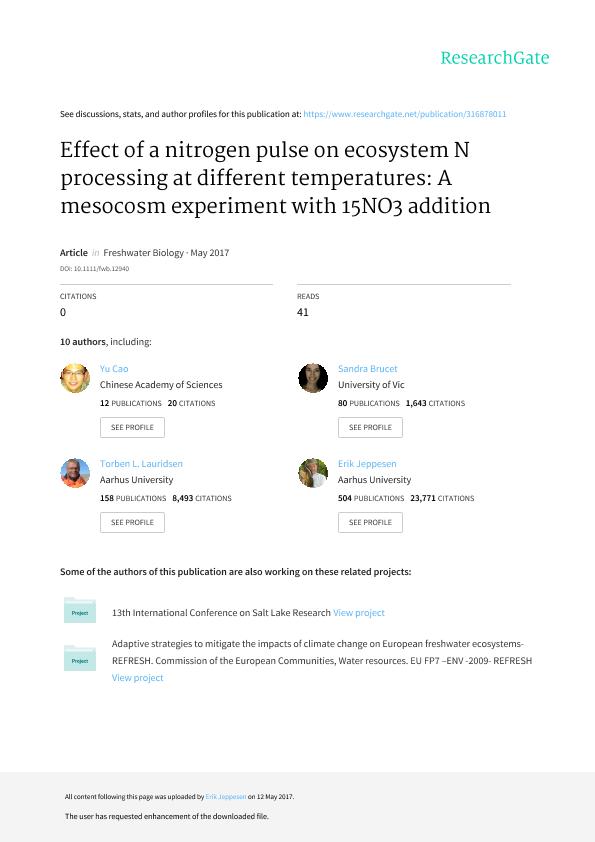Artículo
Effect of a nitrogen pulse on ecosystem N processing at different temperatures: A mesocosm experiment with 15NO3 − addition
Olsen, Saara; Cao, Yu; Gutierrez, Marìa Florencia ; Brucet, Sandra; Landkildehus, Frank; Lauridsen, Torben L.; Davidson, Thomas A.; Søndergaard, Martin; Jeppesen, Erik; Risgaard-Petersen, Nils
; Brucet, Sandra; Landkildehus, Frank; Lauridsen, Torben L.; Davidson, Thomas A.; Søndergaard, Martin; Jeppesen, Erik; Risgaard-Petersen, Nils
 ; Brucet, Sandra; Landkildehus, Frank; Lauridsen, Torben L.; Davidson, Thomas A.; Søndergaard, Martin; Jeppesen, Erik; Risgaard-Petersen, Nils
; Brucet, Sandra; Landkildehus, Frank; Lauridsen, Torben L.; Davidson, Thomas A.; Søndergaard, Martin; Jeppesen, Erik; Risgaard-Petersen, Nils
Fecha de publicación:
07/2017
Editorial:
Wiley Blackwell Publishing, Inc
Revista:
Freshwater Biology (print)
ISSN:
0046-5070
Idioma:
Inglés
Tipo de recurso:
Artículo publicado
Clasificación temática:
Resumen
Shallow lakes may play an important role for the nitrogen (N) balance in drainage basins by processing, transferring and retaining N inputs. An increase in the frequency of storm-induced short-term N pulses and increased water temperatures are both likely outcomes of climate change, potentially affecting the N processing in lakes. An experiment with a K15NO3 − pulse addition (increase in NO3 − concentration from c. 0.1 to 2 mg/L) was carried out in 12 mesocosms with relatively low (applies to Danish lakes) total N (TN) and total phosphorus (TP) concentrations (c. 0.3 mg N L−1 and 0.04 mg P L−1) to assess the effects of an N pulse on N processing and storage in shallow lake ecosystems. The mesocosms have a hydraulic retention time of approximately two and a half months, and at the time of the experiment, they had been adapted to contrasting temperatures for a period of 10 years: ambient, T3 (heating according to the Intergovernmental Panel on Climate Change 2007 A2 scenario, +3.7–4.5°C, depending on season) and T5 (heating with A2 + 50%, +4.9–6.6°C). Macrophytes and filamentous algae retained up to 40% and 30% of the added 15N, respectively, reflecting their high biomass in the mesocosms. Macrophytes and filamentous algae constituted between 70% and 80% of the biomass of all primary producers during the experiment in the T3 and ambient treatments and between 20% and 40% in T5. By comparison, less than 1% of the added 15N diffused to the sediment and less than 5% was lost to the atmosphere as N2 gas. Snails represented the long-term storage of 15N, retaining up to 6% of the tracer and with detectable enrichment 100 days after tracer addition. We found no significant differences among the temperature treatments in the 15N turnover after pulse dosing. However, a larger percentage of 15N was stored in macrophytes in the ambient and T3 mesocosms, reflecting higher biomasses than in T5 where filamentous algae were more abundant. Macrophytes and filamentous algae rather than temperature were therefore key controllers of N processing during the summer N pulse in these shallow, relatively low TP lakes.
Palabras clave:
15n Addition
,
Mesocosm
,
Nitrogen Pulses
,
Primary Production
,
Temperature
Archivos asociados
Licencia
Identificadores
Colecciones
Articulos(INALI)
Articulos de INST.NAC.DE LIMNOLOGIA (I)
Articulos de INST.NAC.DE LIMNOLOGIA (I)
Citación
Olsen, Saara; Cao, Yu; Gutierrez, Marìa Florencia; Brucet, Sandra; Landkildehus, Frank; et al.; Effect of a nitrogen pulse on ecosystem N processing at different temperatures: A mesocosm experiment with 15NO3 − addition; Wiley Blackwell Publishing, Inc; Freshwater Biology (print); 62; 7; 7-2017; 1232-1243
Compartir
Altmétricas



